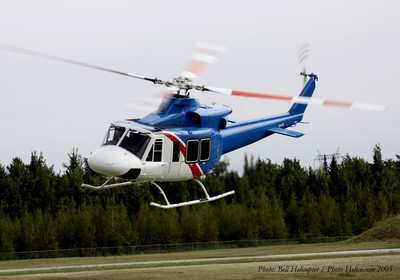Thu, Jul 22, 2010
Potential Low-Cost Option For Hover-Hold And SAR Missions
 Bell Helicopter, working in
cooperation with Esterline CMC Electronics, has developed and
flight tested a new generation GPS sensor to replace existing
high-cost Doppler or inertial velocity sensors used in automated
approach-to-hover and hover-hold systems.
Bell Helicopter, working in
cooperation with Esterline CMC Electronics, has developed and
flight tested a new generation GPS sensor to replace existing
high-cost Doppler or inertial velocity sensors used in automated
approach-to-hover and hover-hold systems.
This new product is anticipated to be available for installation
on the Bell 412EP within the next 12-months with plans to expand
availability to other models.
"The CMC GPS solution proved more responsive in flight test than
both the legacy Doppler and any of the GPS-aided inertial solutions
being examined when tied to the existing 412EP autopilot, but this
is not just for SAR and hover-hold," said Bell's chief technology
officer, Nick Lappos. "We see this technology and the capability it
brings as a means to improve safety in low-speed operations in
general as well as reduce the cost of SAR operations."
The Bell-CMC ground velocity sensor is designed to work with the
existing autopilot systems the Bell-CMC ground velocity sensor
provides law enforcement and emergency medical service (EMS)
operators with significant SAR safety enhancements at an affordable
price.

Bell 412 File Photo
This new offering will provide immediate benefit for Bell 412EP
operators by reducing weight, minimizing installation requirements,
and improving stabilized hover-hold performance. Unaffected by
glassy water, tall grass, under-slung objects or other situations,
the new Bell-CMC sensor avoids many operational constraints that
have traditionally challenged the performance of Doppler
systems.
Established as a stand-alone software upgrade to the Esterline
CMC Electronics CMA-5024 satellite based augmentation systems
(SBAS) GPS receiver, the new Bell-CMC low-cost ground velocity
sensor processes a specific property of the raw GPS signals to
produce an actual velocity measurement versus reporting changes in
GPS positions over time.
Taking advantage of the processing power and high-update rate of
the CMA-5024, and not being limited to WAAS/SBAS coverage, the
system's ground velocity function is usable world-wide.
More News
Aero Linx: JAARS Nearly 1.5 billion people, using more than 5,500 languages, do not have a full Bible in their first language. Many of these people live in the most remote parts of>[...]
'Airplane Bounced Twice On The Grass Runway, Resulting In The Nose Wheel Separating From The Airplane...' Analysis: The pilot reported, “upon touchdown, the plane jumped back>[...]
"Burt is best known to the public for his historic designs of SpaceShipOne, Voyager, and GlobalFlyer, but for EAA members and aviation aficionados, his unique concepts began more t>[...]
"Polaris Dawn, the first of the program’s three human spaceflight missions, is targeted to launch to orbit no earlier than summer 2024. During the five-day mission, the crew >[...]
There Are SO Many Ways To Get YOUR Aero-News! It’s been a while since we have reminded everyone about all the ways we offer your daily dose of aviation news on-the-go...so he>[...]
 ANN's Daily Aero-Linx (05.04.24)
ANN's Daily Aero-Linx (05.04.24) NTSB Final Report: Quest Aircraft Co Inc Kodiak 100
NTSB Final Report: Quest Aircraft Co Inc Kodiak 100 Aero-News: Quote of the Day (05.04.24)
Aero-News: Quote of the Day (05.04.24) Aero-News: Quote of the Day (05.05.24)
Aero-News: Quote of the Day (05.05.24) Read/Watch/Listen... ANN Does It All
Read/Watch/Listen... ANN Does It All




